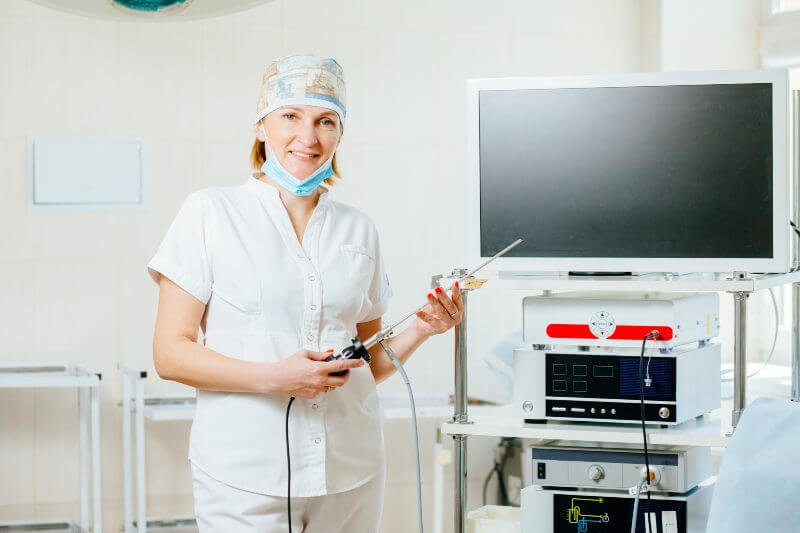The office hysteroscopy is an important medical breakthrough. It has made it possible for surgeons to evaluate the intrauterine cavity and do surgical interventions less invasively with lower complications and less recovery time than with conventional medical surgeries through laparotomy.
A hysteroscopy is an endoscopic procedure where a thin tube enhanced with a miniscule camera (endoscope) is inserted in the vagina, passes through the cervix into the uterine cavity. The video image recordings made by this camera are projected on a screen so for evaluation. Surgical interventions if needed in many cases are possible via another tube through which scissors, cutters and diathermia can be inserted. The major benefit of this procedure apart from it being less invasive is the fact that it is not just a diagnostic tool but can also be a surgical one. Diagnosis and treatment of certain anomalies or diseases can be done in one setting
The importance of hysteroscopy
The Importance of hysteroscopy is mainly to diagnose and treat intrauterine anomalies these; could have been observed during a routine ultrasound sonography and require further investigation. A hysteroscopy can also be requested by your doctor due to your medical history of recurrent abortion, several failed IVF/ICSI trials or because no pregnancy occurs and you and your partner both have no other factors that could explain your infertility.
The endoscope that enters the uterine cavity through the cervix and displays a video image on a screen is an important diagnostic tool of the cervix, endometrial lining, uterine cavity and tubal orifices (the place where the tubes enter the uterus). The importance of hysteroscopy in gynecology lays mainly in the fact that it offers surgical therapeutic intervention with minimum invasion. It can remove fibroids, uterine septum, adhesions and polyps. A hysteroscopy can also help while doing a Dilatation and Curettage (D&C) to take samples to determine why the menstrual cycle is heavier than normal. A hysteroscopy is best not to be performed during the menstrual cycle unless your doctor recommends otherwise. A hysteroscopy can be done in a clinic setting if your doctor sees fit or in a hospital setting if anesthesia is required.
Hysteroscopy is important as mentioned above for diagnostic and surgical treatment during the same procedure of the following;
- Congenital abnomalies of the uterus such as having a uterine septum
- Adhesions
- Fibroids indenting the uterine cavity
- Polyps growing inside the uterine cavity acting as an intrauterine device (IUD)
- Anomalies of the cervix that could prohibit or decrease the chances of sperm reaching the uterus
- The orifices (opening) of the fallopian tubes into the uterus
Hysteroscopy steps
The steps of hysteroscopy first depend on whether anesthesia is required. In case it is the patient will arrive at the clinic or hospital having fasted for at least 6 hours.
The patient conscious or after having been sedated by the anesthesiologist will be put comfortably in the gynecological chair and the legs put up in stirrups. The endoscope will be inserted through the vagina and cervix to reach the uterine cavity all while being inflated by gas or fluid so the structures could be properly accessed while being filmed by the camera. If, needed an extra tube with surgical tools will be inserted for intervention.
Hysteroscopy costs
Hysteroscopy costs vary between different clinics and hospitals, whether anesthesia is required, the skills of the practicing surgeon, the initial reason or diagnosis that requires the hysteroscopy, and/or if surgical intervention is required. Sometimes the hysteroscopy costs turn out to be more than initially estimated because an unforeseen intervention might have taken place.
To avoid sudden extra costs of hysteroscopy, talk to your doctor and simply ask him why do I need a hysteroscopy? What do you think you will find? What might be the type of required surgical interventions?
Why do I need a hysteroscopy in IVF /ICSI?
Numerous research has shown that implantation rates (positive pregnancy tests) in an IVF/ICSI trial are higher after having conducted a hysteroscopy with endometrial scratching 3-6 months prior to the Embryo Transfer (ET) of these IVF/ICSI trials. Therefore, Bedaya Hospital as part of our standard protocol offers a hysteroscopy before starting an IVF/ICSI trial.
Pregnancy after a hysteroscopy
There is no data available so far that indicates having to postpone pregnancy after hysteroscopy surgical intervention.
Pregnancies that happen after a hysteroscopy or hysteroscopic surgical intervention progress in the same way as pregnancies that occurred without doing a hysteroscopy.
Our team at Bedaya Hospital is always ready to advice you and explain the benefits of a hysteroscopy in your situation. Our endoscopes are state of the art and our team of surgeons are highly skilled in using the endoscope.






